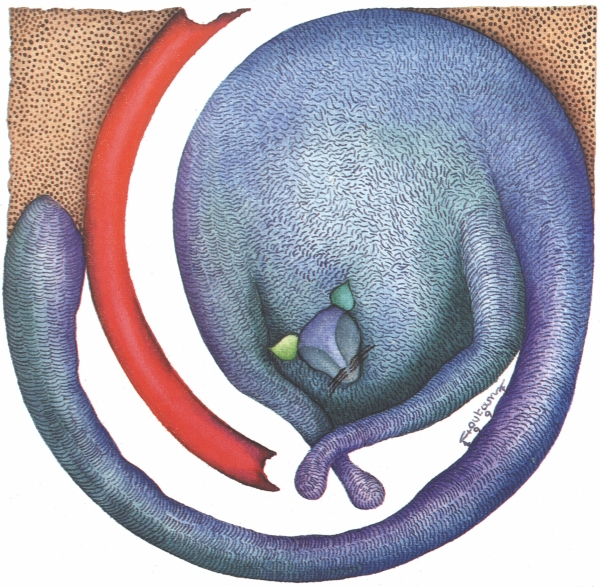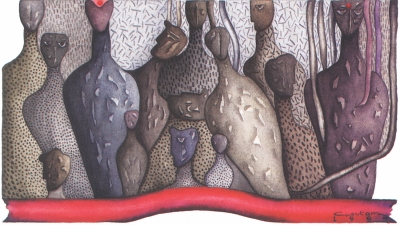| Home - Back Issues - The Team - Contact Us |
 |
| Volume 11 |Issue 18 | May 04, 2012 | |
|
|
Profile
An Eye for Good Art Fayza Haq Goutam Chakraborty, a painter by passion and entrepreneur by profession has managed to integrate both art and business in the most harmonious way. His Galleri Kaya in Uttara has been promoting the art work of many new and promising artists while providing an attractive venue for art lovers. His own work, which he has not been able to pursue as diligently as he would have wanted, gives a glimpse of the perfectionist in him. He creates images that have the precision of a mathematician with colours that blend perfectly and tastefully, never jarring to the eye, always balanced even in his expressions of violence, anger or desire. The son of one of the most prominent artists of Bangladesh, Debdas Chakraborty, the soft-spoken, self effacing artist talks about his journey into the world of art.
Goutam a painter and print-maker says, “My father was basically a painter. Ours was a family where artistic activities such as music, poetry, art etc. flourished.” Goutam had developed a love for painting and other affiliated subjects at an early age. He had done his schooling in Shantiniketan and decided to study architecture but his mother's untimely death left him shattered. Next Goutam joined the Faculty of Fine Arts, Dhaka University. Since renowned artist Rashid Chowdhury, famous for his Tapestry work, was there to guide, Goutam's life proceeded in almost an idyll, compared to the life of most aspiring artists of today. Artistes from the upper echelons of the city, like Murtaja Baseer, Aminul Islam, poet Shamsur Rahman, Syed Shamsul Haque and others became his earliest source of inspiration. He at present does a lot of graphic designing. However, Goutam has always wanted to be a painter in water-colour and oil. Much earlier, at the Shilpakala Academy in 1992 and1997, Goutam has had two exhibitions with subtle and sophisticated water colour paintings, with series on animals, reptiles, faces in procession, adolescence, portraits, etc. Commenting on the rapport between the teachers and students in his student days and now, Goutam says, “In my time, in the early eighties, Dhaka was definitely different. One should persevere to improve the situation before the atmosphere grows from bad to worse to insufferable and incorrigible. Surely one should not take shelter behind excuses. We regarded our teachers as actual 'gurus'.” One should act and work for one's aims, Goutam insists. Asked to speak for himself as a painter and patron of arts, the artist cum gallery owner says, “the gallery has had about 58 exhibitions, four art camps and one workshop so far and recently, as Gallery Kaya's patron, I'm encouraging the lesser known but talented artists, who require patronage to be recognised.”
He is not interested in making his gallery just a sales centre, “Of course one needs finance but that is not my ultimate goal. I may not be extremely rich, but I have the guts to carry on with my ultimate goal of projecting the best in fine arts of Bangladesh, in my own way. My latest venture has been 'Obhishek': in this project we hope to hold one exhibition each year.” Goutam says that the majority of his gallery's patrons are local aesthetes. Touching the topic of art appreciation, Goutam adds that there is a dearth of analytic criticism: if this takes place, the perception of the critique would present some insight of the artist and his/her work. “Constructive criticism encourages the artist; in this manner a perception is created. Rave reviews alone are not enough. The artist and the art world, in this manner, would glean much from constructive comments.” In his series on the Liberation War, “Red Hot Iron Bar”, he has depicted Jahanara Imam and Mother Teresa, as well as the animals and other figures have a life of their own. There is nothing to parallel the colours, contours, lines and images of his exquisite works.
|
||||||||
|


